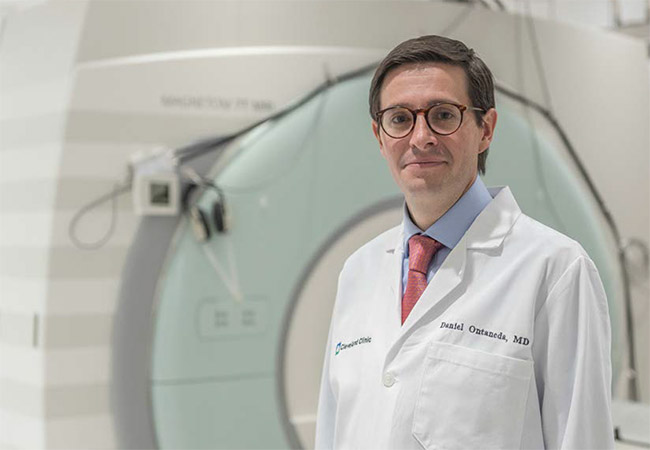#AANAM – 2 Trials Aim to Decide Best Early Way of Treating RRMS, Cleveland Clinic Doctor Says

Daniel Ontaneda, a neurologist at the Cleveland Clinic. (Photo courtesy of Cleveland Clinic)
Two ongoing clinical trials may help doctors better understand which type of disease-modifying therapy — those considered highly effective or those with low-to-moderate efficacy used in an escalating treatment approach — would be best for people in the early stages of relapsing-remitting multiple sclerosis (RRMS), according to a Cleveland Clinic neurologist who is leading one of these studies.
Highly effective disease-modifying therapies, or HETs, are potentially more risky in terms of side effects than those with lower-to-moderate effectiveness (LMTs) given in “traditional,” escalating steps.

Daniel Ontaneda, a neurologist with the Cleveland Clinic, is leading DELIVER-MS. (Photo courtesy of Cleveland Clinic)
“The goal of the studies is to inform the decision-making process,” Daniel Ontaneda, a neurologist, said in an interview with Multiple Sclerosis News Today at the recent annual meeting of the American Academy of Neurology (AAN) held in Philadelphia.
Ontaneda is lead investigator for DELIVER-MS (NCT03535298), which he described as a 24-site study in the U.S. and the U.K. It is currently enrolling up to 800 RRMS patients and is expected to end in September 2023.
“We think that the study will answer what treatment philosophy should you take — is it better to hit hard with one of our most effective medications at the beginning or use this escalation approach, which is to start with a low- or moderate-efficacy medication?” Ontaneda said.
The other trial, called TREAT-MS (NCT03500328) and led by researchers at Johns Hopkins, aims to enroll 900 RRMS patients at 43 sites across the U.S. It’s set to conclude in October 2022.
“I think our bias is probably that the earlier you treat, the harder you treat at the beginning, those patients will probably do better,” Ontaneda said. But escalating patients well “might be as good as starting … [HETs] from the get-go.”
Weighing benefits and risks
Four MS medications considered to be HETs are in each trial: Tysabri (natalizumab, by Biogen), Lemtrada (alemtuzumab, by Sanofi-Genzyme), Ocrevus (ocrelizumab, by Genentech), and rituximab — an off-label therapy, marketed as Rituxan in the U.S. by Genentech and Biogen, and as MabThera by Roche in Europe, and approved to treat certain autoimmune diseases and blood cancers.
What distinguishes these four from other FDA-approved MS therapies — specifically those injectable therapies with “very favorable long-term safety profile[s]?”
HETs are all infusion treatments and monoclonal antibodies, Ontaneda said, meaning they “have a very precise mechanism of action” within the immune system. Monoclonal antibodies are molecules that bind to antigens on specific cells or pathogens, with a goal of promoting their destruction. “We know what receptor they’re hitting and exactly what they’re doing, so they’ve been more engineered in a sense,” he said. “They’ve been more designed.”
While Ocrevus and rituximab target immune B-cells, Tysabri works by blocking T-cells from entering the brain. Lemtrada targets both B- and T-cells. “The mechanisms are quite different, but it’s interesting when you look at the effects they have in the trials … they’re actually pretty similar.”
While more effective, HETs also “tend to have more risks,” Ontaneda said, giving as an example Lemtrada, which is currently under review in Europe due to reports of serious side effects. Pending that review’s outcome, Lemtrada can only be newly prescribed in the EU to patients with active relapses who fail to respond to at least two other disease-modifying therapies.
But safety and tolerability concerns are not always clear-cut, and some “medications in high efficacy groups … from a safety profile look better than medications in the moderate group,” Ontaneda said, noting that their use in earlier disease stages is rising — as a study presented at AAN showed — although they are still a less favored early treatment approach.
Still, the risk of insufficiently treating — “undertreating” — MS, “probably outweighs the risk in many cases of a potentially rare side effect,” he added.
“I always go back to this concept that we take a lot of risks on a day-to-day basis,” Ontaneda said. “I walked over here across several streets, probably crossed as the light was changing, and what’s my risk every time I do that? … The risks of car accidents, the risks of plane accidents are not too unlike the risks we’re talking about with these medications. The idea is that we have to adjust our risk to account for what we’re getting the benefit for.”
Crafting a guide for better treatment
Data from DELIVER-MS and TREAT-MS will be pooled so that results — fairly long-term data on “what’s going to happen … if you go with medication A or B” — are from a larger set of patients.
Participants in both studies will be randomly assigned to one of the four HETs or to an LMT, which range from glatiramer acetates like Copaxone and Glatopa to interferons like Avonex, Betaseron, Extavia, Rebif and Plegridy, and others like Aubagio (teriflunomide), Tecfidera (dimethyl fumarate) and Gilenya (fingolimod).
Each study differs from previous trials in that “we are not randomizing to a given medication; we’re randomizing to a treatment philosophy,” Ontaneda said.
Usually, treatment decisions in MS are based on the results of trials that compare a given therapy to a placebo, so that a therapy’s effectiveness is known but almost in isolation. One result “is that we’ve kind of used these medications somewhat haphazardly,” Ontaneda said, with considerable variation among treating physicians “even in the same clinic.”
There’s no “established … good grading of scientific evidence of what medication do you use first.”
That’s what these trials hope to establish — or at least lend clear scientific support to.
“I think it’s going to be very, very interesting,” Ontaneda said of his trial. “If it shows that [HETs] used early prevent … brain volume loss that would be predictive of long-term disability, that, for sure, would probably push us to use more highly effective medications.” But if the two approaches are found to be equally effective, “that perhaps would push us to say, ‘yeah, we have to be thoughtful; maybe all patients don’t need [HETs], maybe we can mitigate risk.'”
DELIVER-MS will also have an observational, survey-based study arm for people not willing to take part in a randomized clinical trial and allocated to a particular treatment. Results from each will be evaluated.
“We need a randomized clinical trial because that’s the highest degree of [scientific] evidence, but we probably also need some observational data to go on and see how the results compare.”
Looking toward future choices
Another goal of both DELIVER-ME and TREAT-MS is to help guide choices made by payers, especially insurance companies in the U.S.
Many prefer LMTs as initial treatments, and factor in prices negotiated with manufacturers. Many also weigh in their considerations the likelihood that patients using an effective but expensive therapy for two years — one whose efficacy reaches out, say, five years — often switch insurance carriers every two years. A second company, in other words, benefits from the expenses paid by the first.
An insurance company executive helping in the DELIVER-MS study made that “interesting” point clear, Ontaneda said, when the two were discussing payer support for more costly therapies with longer-term benefits. “That’s kind of one of the things that’s a reality of our private insurance-payer mix in the United States,” he added.
Another possible reason is that the risks of not treating or poorly treating MS are not truly quantified, as they are with strokes. There’s “a very clear trade-off” understood by doctors and patients in taking or decline a stroke treatment, and that’s lacking when choosing among MS medications, Ontaneda said.
DELIVER-MS investigators are also drawing blood samples to try to find biomarkers able to predict responses to individual therapies. The creation of such biobank is supported by the National Multiple Sclerosis Society.
“The question is should we take a cookie-cutter approach where we say everybody should be on highly effective or should we develop biomarkers that say, this is a patient that’s going to respond to X, Y, or Z medication,” Ontaneda said.
One potential blood biomarker is neurofilament light chain (NfL), a marker of nerve fiber damage. “I think a lot of the validation data is already present” from previous clinical trial populations, he said. “We know that it responds to treatment; we know that it’s predictive of clinical disability and also both OCT [optical coherence tomography] and brain volume changes. So we think it’s an attractive marker.”
Further evaluating this possible biomaker in RRMS patients taking part in DELIVER-MS “is the ideal data set,” Ontaneda added, as their treatment responses need to be followed over time.






